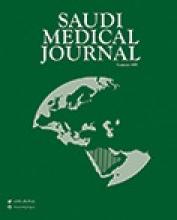Abstract
OBJECTIVE: To study the episodes of Staph.aureus bacteremia diagnosed at King Abdulaziz University Hospital, to determine the source of infection, risk factors, the outcome of treatment and to compare our results with those reported in the literature.
METHODS: A retrospective study in which the episodes of Staph.aureus bacteremia diagnosed at King Abdulaziz University Hospital, Jeddah, Kingdom of Saudi Arabia in the period from June 1996 to December 1998 were analyzed.
RESULTS: A total of 103 episodes of Staph.aureus bacteremia were diagnosed in 95 patients with a mean age of 33.61 years (range 2 months to 90 years) and male:female ratio of 1.9:1. More than 50% of patients were Saudi nationals. Hospital-acquired infection was detected in 74% of the episodes versus 25% community-acquired. Methicillin resistant Staph.aureus was found in 29% of the episodes. Intravenous catheters and wounds were the main sources of bacteremic episodes (29% and 21%). The overall mortality was 32% with significant association with old age, diabetes mellitus and hemodialysis for renal failure. Risk factors such as surgical wounds, diabetes mellitus and malignancy, were more frequently associated with hospital-acquired than community-acquired bacteremia. Infective endocarditis was higher in patients with community-acquired bacteremia who had unknown source of infection.
CONCLUSION: As discussed in the text, our results are comparable with those reported in the literature. Insertion of intravenous catheters under aseptic precaution, better care and judicious limitation of patients length of exposure to central line, in addition to proper wound dressings could reduce the frequency of blood stream infections.
- Copyright: © Saudi Medical Journal
This is an open-access article distributed under the terms of the Creative Commons Attribution-Noncommercial-Share Alike 3.0 Unported, which permits unrestricted use, distribution, and reproduction in any medium, provided the original work is properly cited.






